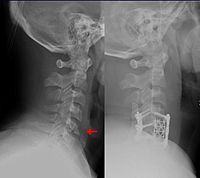
Photo from wikipedia
PurposeInformation about the cost-effectiveness of surgical procedures for adult spinal deformity (ASD) is critical for providing appropriate treatments for these patients. The purposes of this study were to compare the… Click to show full abstract
PurposeInformation about the cost-effectiveness of surgical procedures for adult spinal deformity (ASD) is critical for providing appropriate treatments for these patients. The purposes of this study were to compare the direct cost and cost-effectiveness of surgery for ASD in the United States (US) and Japan (JP).MethodsRetrospective analysis of 76 US and 76 JP patients receiving surgery for ASD with ≥2-year follow-up was identified. Data analysis included preoperative and postoperative demographic, radiographic, health-related quality of life (HRQOL), and direct cost for surgery. An incremental cost-effectiveness ratio (ICER) was determined using cost/quality-adjusted life years (QALY). The cost/QALY was calculated from the 2-year cost and HRQOL data.ResultsJP exhibited worse baseline spinopelvic alignment than the US (pelvic incidence and lumbar lordosis: 35.4° vs 22.7°, p < 0.01). The US had more three-column osteotomies (50 vs 16%), and shorter hospital stay (7.9 vs 22.7 days) (p < 0.05). The US demonstrated worse postoperative ODI (41.3 vs. 33.9%) and greater revision surgery rate (40 vs 10%) (p < 0.05). Due to the high initial cost and revision frequency, the US had greater total cost ($92,133 vs. $49,647) and cost/QALY ($511,840 vs. $225,668) at 2-year follow-up (p < 0.05).ConclusionRetrospective analysis comparing the direct costs and cost-effectiveness of ASD surgery in the US vs JP demonstrated that the total direct costs and cost/QALY were substantially higher in the US than JP. Variations in patient cohort, healthcare costs, revision frequencies, and HRQOL improvement influenced the cost/QALY differential between these countries.
Journal Title: European Spine Journal
Year Published: 2017
Link to full text (if available)
Share on Social Media: Sign Up to like & get
recommendations!